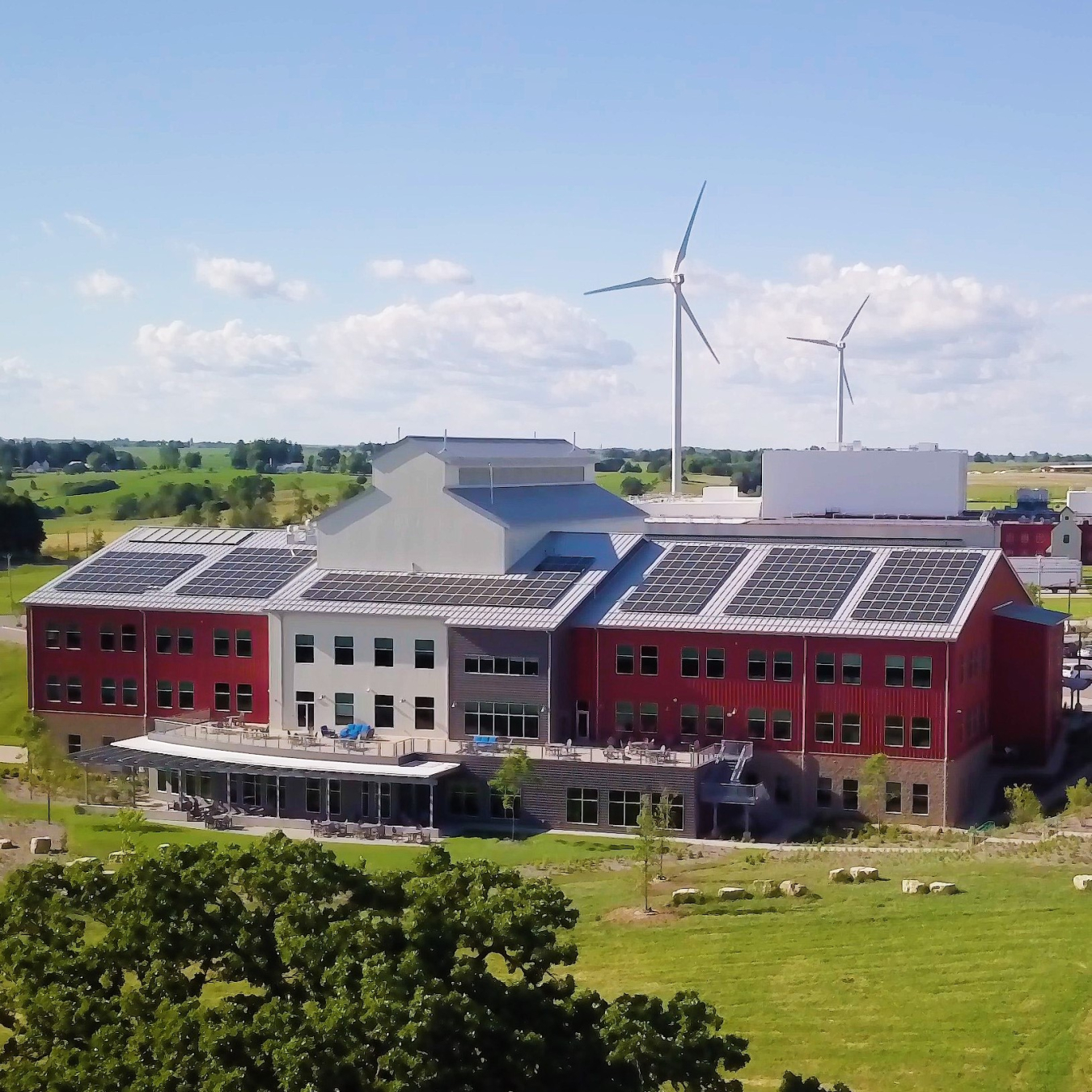The biannual U.S. Department of Energy (DOE) Wind Research and Development (R&D) Newsletter provides recent news about the DOE Wind Energy Technologies Office's (WETO) R&D projects, news, accomplishments, and recent publications.
Current Research & Development
Unlocking Distributed Wind Energy’s Potential
NREL study identifies opportunities for widespread deployment of distributed wind energy
A comprehensive analysis released by the National Renewable Energy Laboratory (NREL) indicates that nearly 1,400 gigawatts (GW) of distributed wind capacity could be profitably deployed today across the United States. This amounts to more than half of the nation’s current annual electricity consumption and is a big increase from the 1.1 GW installed today.
“This study shows that distributed wind energy could bring clean power to millions of American households,” said Eric Lantz, NREL principal investigator of the study. “Distributed wind energy offers significant potential to help communities transition to a clean energy future and can deliver power to residential and industrial users near where it’s generated, without a need for transmission system expansion.”
The Distributed Wind Energy Futures Study highlights the technical and economic potential for distributed wind energy deployment at all scales—from kilowatts to megawatts—and considers opportunities for distributed wind energy in agricultural, commercial, industrial, and residential settings and in disadvantaged communities.
-
 New study reveals mixed reactions to flickering shadows generated by wind turbines.
New study reveals mixed reactions to flickering shadows generated by wind turbines. -
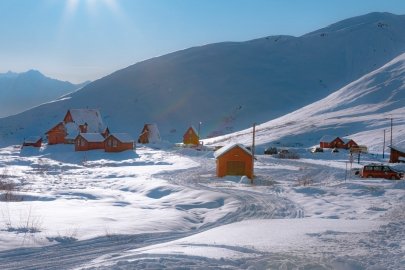 A standalone wind turbine is transforming the rural Alaskan community of St. Mary’s, according to a new study conducted by Pacific Northwest National Laboratory and Sandia National Laboratories.
A standalone wind turbine is transforming the rural Alaskan community of St. Mary’s, according to a new study conducted by Pacific Northwest National Laboratory and Sandia National Laboratories. -
 NREL report outlines supply chain needs required to reach the United States’ national offshore wind goal of 30 GW by 2030.
NREL report outlines supply chain needs required to reach the United States’ national offshore wind goal of 30 GW by 2030. -
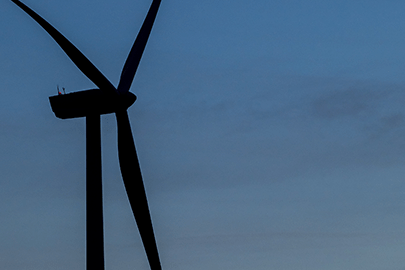 First-ever demonstration shows wind can fulfill a wider role in future power systems.
First-ever demonstration shows wind can fulfill a wider role in future power systems. -
 The American WAKE experimeNt—a massive data collection effort funded by WETO—could help U.S. wind farms produce more energy, increase profits, and, eventually, reduce electricity prices for consumers.
The American WAKE experimeNt—a massive data collection effort funded by WETO—could help U.S. wind farms produce more energy, increase profits, and, eventually, reduce electricity prices for consumers. -
 After 31 years at the Pacific Northwest National Laboratory, Wind Energy Program Manager Will Shaw has retired. From the Atmosphere to Electrons initiative to offshore wind buoys, it’s been a wind energy career he’s enjoyed with “gust-o.”
After 31 years at the Pacific Northwest National Laboratory, Wind Energy Program Manager Will Shaw has retired. From the Atmosphere to Electrons initiative to offshore wind buoys, it’s been a wind energy career he’s enjoyed with “gust-o.”


As CLEANPOWER 2022 gets underway, we’re all excited to see DOE’s 2022 Collegiate Wind Competition (CWC) taking place live and in-person. If you’re attending CLEANPOWER, you can observe the competition—in whole or part—by making your way to the competition area located in the exhibit hall. CWC always provides an eye-opening look into the future of wind energy through the tremendous efforts of these talented competitors.

-
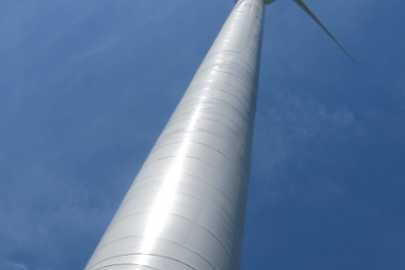 Learn how Keystone Tower Systems is using spiral welding to revolutionize wind turbine manufacturing.
Learn how Keystone Tower Systems is using spiral welding to revolutionize wind turbine manufacturing. -
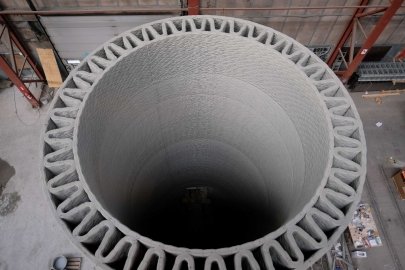 EERE Deputy Assistant Secretary of Renewable Power Alejandro Moreno attended the ribbon-cutting ceremony for a new 3-D printer at a GE research facility in Bergen, NY. Read how this technology is making tall wind turbines easier to build.
EERE Deputy Assistant Secretary of Renewable Power Alejandro Moreno attended the ribbon-cutting ceremony for a new 3-D printer at a GE research facility in Bergen, NY. Read how this technology is making tall wind turbines easier to build. -
 Researchers from NREL explore challenges related to the expansion of wind power as the United States works to meet decarbonization goals.
Researchers from NREL explore challenges related to the expansion of wind power as the United States works to meet decarbonization goals. -
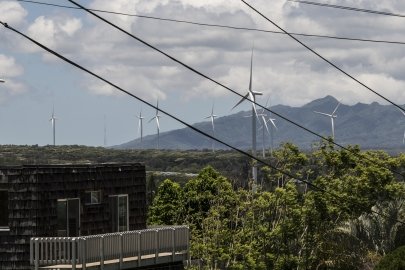 Over the past decade, the wind fleet’s average capacity factor has increased substantially. Researchers have been debating how much of the improvement should be credited to technology versus increasing wind speeds.
Over the past decade, the wind fleet’s average capacity factor has increased substantially. Researchers have been debating how much of the improvement should be credited to technology versus increasing wind speeds. -
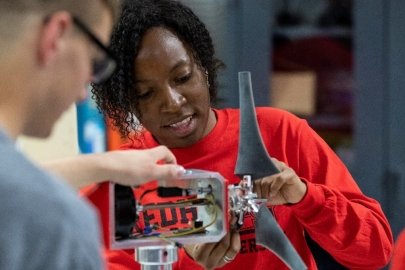 Interested in joining the next generation of wind energy industry professionals? Apply today to participate in the 2023 Collegiate Wind Competition! We’re accepting applications through June 20, 2022.
Interested in joining the next generation of wind energy industry professionals? Apply today to participate in the 2023 Collegiate Wind Competition! We’re accepting applications through June 20, 2022. -
 NREL report outlines supply chain needs required to reach the United States’ national offshore wind goal of 30 GW by 2030.
NREL report outlines supply chain needs required to reach the United States’ national offshore wind goal of 30 GW by 2030. -
 The Supply Chain Report is supported by seven deep-dive assessments on the challenges and opportunities to build domestic supply chains for clean energy technologies.
The Supply Chain Report is supported by seven deep-dive assessments on the challenges and opportunities to build domestic supply chains for clean energy technologies. -
 DOE’s Oak Ridge National Laboratory and National Renewable Energy Laboratory have published a study as part of the MADE3D initiative, highlighting 3D printing of magnetic components for large electrical machines like wind turbines.
DOE’s Oak Ridge National Laboratory and National Renewable Energy Laboratory have published a study as part of the MADE3D initiative, highlighting 3D printing of magnetic components for large electrical machines like wind turbines. -
The National Offshore Wind R&D Consortium has announced six new projects to support supply chain efficiency, asset monitoring, and inspection.
-
Report details regional and national strategies to support the Administration’s goals for offshore wind deployment
-
 WETO has released phase I findings for its Big Adaptive Rotor project, studying large blades for low-specific-power wind turbines.
WETO has released phase I findings for its Big Adaptive Rotor project, studying large blades for low-specific-power wind turbines. -
DOE national laboratory researchers have determined a way to transport massive wind turbine blades at a lower cost, by designing them to bend, or deflect, by 20%.
-
DOE national labs and industry partner Vestas published a report discussing how 3-D printing may hold promise for producing specific wind energy components.
-
National lab study will study will evaluate multiple pathways to OSW goals through coordinated transmission solutions along the Atlantic in the near-term (2030) and long-term (2050), under various generation mix and load futures.

- Accelerated Wind-Turbine Wake Recovery Through Actuation of the Tip-Vortex Instability
- Addressing Deep Array Effects and Impacts to Wake Steering With the Cumulative-Curl Wake Model[preprint]
- Blade Planform Design Optimization To Enhance Turbine Wake Control
- Evaluating Terrain as a Turbulence Generation Method
- Experimental Results of Wake Steering Using Fixed Angles
- High-Fidelity Wind Farm Simulation Methodology With Experimental Validation
- Improved Representation of Horizontal Variability and Turbulence in Mesoscale Simulations of an Extended Cold-Air Pool Event
- Large-Eddy Simulation of a Wind Turbine Using a Filtered Actuator Line Model
- Meso- to Microscale Modeling of Atmospheric Stability Effects on Wind Turbine Wake Behavior in Complex Terrain
- Numerical Investigation of Wind Turbine Wakes Under High Thrust Coefficient
- On Turbulence Models and Lidar Measurements for Wind Turbine Control
- Region-Based Convolutional Neural Network for Wind Turbine Wake Characterization in Complex Terrain Remote Sensing
- Results From a Wake-Steering Experiment at a Commercial Wind Plant: Investigating the Wind Speed Dependence of Wake-Steering Performance
- Scientific Challenges to Characterizing the Wind Resource in the Marine Atmospheric Boundary Layer
- The Sensitivity of the Fitch Wind Farm Parameterization to a Three-Dimensional Planetary Boundary Layer Scheme[preprint]
- Time-Averaged Wind Turbine Wake Flow Field Prediction Using Autoencoder Convolutional Neural Networks
- Wind Plant Performance Prediction Benchmark Phase 1 Technical Report
- Wind Plants Can Impact Long-Term Local Atmospheric Conditions
- 2020 Cost of Wind Energy Review
- 2021 Standard Scenarios Report: A U.S. Electricity Sector Outlook
- Plentiful Electricity Turns Wholesale Prices Negative
- Potential Infrastructure Cost Savings at Hybrid Wind Plus Solar PV Plants
- Scaling Trends for Balance-of-System Costs at Land-Based Wind Power Plants: Opportunities for Innovations in Foundation and Erection
- School District Revenue Shocks, Resource Allocations, and Student Achievement: Evidence From the Universe of U.S. Wind Energy Installations
- Variable Renewable Energy Participation in U.S. Ancillary Services Markets: Economic Evaluation and Key Issues
- A Cyber-Resilience Risk Management Architecture for Distributed Wind
- A Physics-informed Data-driven Low Order Model for the Wind Velocity Deficit at the Wake of Isolated Buildings
- Cybersecurity for Distributed Wind: What Manufacturers Need to Know
- Cybersecurity for Distributed Wind: What Operators Need to Know
- Cybersecurity for Distributed Wind: What Implementers Need to Know
- Deployable Wind-Hybrid Power Systems for Defense and Disaster Response Applications
- Design Guidelines for Deployable Wind Turbines for Military Operational Energy Applications
- Design Innovations for Deployable Wind Turbines
- Distributed Wind Energy Futures Study
- Integration of Storage in the DC Link of a Full Converter-Based Distributed Wind Turbine
- Load Control for Frequency Response – A Literature Review
- Valuation of Distributed Wind in an Isolated System
- Acoustic and Genetic Data Can Reduce Uncertainty Regarding Populations of Migratory Tree-Roosting Bats Impacted by Wind Energy
- Acoustic Exposure to Turbine Operation Quantifies Risk to Bats at Commercial Wind Energy Facilities
- An Updated Review of Hypotheses Regarding Bat Attraction to Wind Turbines
- Influencing Activity of Bats by Dimly Lighting Wind Turbine Surfaces With Ultraviolet Light
- Introduction of New Offshore Wind Farm Structures: Effects on Fish Ecology
- Stochastic Agent-Based Model for Predicting Turbine-Scale Raptor Movements During Updraft-Subsidized Directional Flights
- Tethys: Enhancing the Understanding of Environmental Effects of Wind Energy
- Atlantic Offshore Wind Transmission Literature Review and Gaps Analysis
- Decentralized Data-Driven Estimation of Generator Rotor Speed and Inertia Constant Based on Adaptive Unscented Kalman Filter
- Design and Operation of Energy Systems With Large Amounts of Variable Generation: Final Summary Report, IEA Wind TCP Task 25
- Distributed Frequency Divider for Power System Bus Frequency Online Estimation Considering Virtual Inertia From DFIGs
- Evaluating the Interactions Between Variable Renewable Energy and Diurnal Storage
- Integration of Distributed Controllers: Power Reference Tracking Through Charging Station and Building Coordination
- MIRACL Co-Simulation Platform for Control and Operation of Distributed Wind in Microgrid
- The North American Renewable Integration Study: A U.S. Perspective
- Storage Futures Study: Grid Operational Impacts of Widespread Storage Deployment
- Storage Futures Study: The Challenge of Defining Long-Duration Energy Storage
- The Virtualized Cyber-Physical Testbed for Machine Learning Anomaly Detection: A Wind Powered Grid Case Study
- Wind and Solar Hybrid Power Plants for Energy Resilience
- Wind Systems Integration Workshop
- 3D Printing of Anisotropic Sm–Fe–N Nylon Bonded Permanent Magnets
- Achieving American Leadership in the Wind Supply Chain
- Additive manufacturing of soft magnets for electrical machines—a review
- America’s Strategy to Secure the Supply Chain for a Robust Clean Energy Transition
- Wind Energy Supply Chain Deep Dive Assessment
- Big Adaptive Rotor Phase I Final Report
- Challenges and Opportunities for Airborne Wind Energy in the United States
- Flexing the Limits of Land-Based Wind Turbine Rotor Growth
- Land-Based Wind Turbines With Flexible Rail-Transportable Blades – Part 2: 3D Finite Element Design Optimization of the Rotor Blades
- The American WAKE experimeNt (AWAKEN)
- Up-Tower Investigation of Main Bearing Cage Slip and Loads
- WhiteWind: White Etching Crack (WEC) Bearing Failures in Wind Turbines: Cooperative Research and Development Final Report
- Wind Turbine Drivetrains: State-of-the-Art Technologies and Future Development Trends
- Wind Turbine Gearbox Reliability Assessment: Value of Increased Reliability and Reduced Operations and Maintenance Costs
- A Reference Open-Source Controller for Fixed and Floating Offshore Wind Turbines
- A Review of Modelling Techniques for Floating Offshore Wind Turbines
- Assessing Boundary Condition and Parametric Uncertainty in Numerical-Weather-Prediction-Modeled, Long-Term Offshore Wind Speed Through Machine Learning and Analog Ensemble
- Comparison of the Gaussian Wind Farm Model With Historical Data of Three Offshore Wind Farms
- The Demand for a Domestic Offshore Wind Supply Chain
- Demonstration of NREL Modeling Capability To Design the Next Generation of Floating Offshore Wind Turbines with Stiesdal and Magellan Wind: Cooperative Research and Development Final Report
- Linearized Modeling and Optimization of Shared Mooring Systems
- Modeling the TetraSpar Floating Offshore Wind Turbine Foundation as a Flexible Structure in OrcaFlex and OpenFAST
- OC6 Phase I: Improvements to the OpenFAST Predictions of Nonlinear, Low-Frequency Responses of a Floating Offshore Wind Turbine Platform
- OC6 Phase Ia: CFD Simulations of the Free-Decay Motion of the DeepCwind Semisubmersible
- OC6 Phase Ia: Definition Document: Validation of Nonlinear Hydrodynamic Loading on the DeepCwind Semisubmersible
- OC6 Phase Ib: Floating Wind Component Experiment for Difference-Frequency Hydrodynamic Load Validation
- OC6 Phase II: Integration and Verification of a New Soil-Structure Interaction Model for Offshore Wind Design
- Offshore Wind Energy Strategies: Regional and National Strategies to Accelerate and Maximize the Effectiveness, Reliability, and Sustainability of U.S. Offshore Wind Energy Deployment and Operation
- Analysis of Leading Edge Protection Application on Wind Turbine Performance Through Energy and Power Decomposition Approaches
- Evaluation of Coupled Wind / Wave Model Simulations of Offshore Winds in the Mid-Atlantic Bight using lidar-equipped buoys
- Machine Learning Enables National Assessment of Wind Plant Controls With Implications for Land Use
- Offshore Wind Energy Forecasting Sensitivity to Sea Surface Temperature Input in the Mid-Atlantic[preprint]
- Scientific Challenges to Characterizing the Wind Resource in the Marine Atmospheric Boundary Layer[preprint]
- Time Evolution and Diurnal Variability of the Parametric Sensitivity of Turbine-Height Winds in the MYNN-EDMF Parameterization
- What Can Surface Wind Observations Tell Us About Interannual Variation in Wind Energy Output?
- “After the Leases Are Signed, It's a Done Deal”: Exploring Procedural Injustices for Utility-Scale Wind Energy Planning in the United States
- Dynamic Land Use Implications for Rapidly Expanding and Evolving Wind Power Deployment
- In the Shadow of Wind Energy: Predicting Community Exposure and Annoyance to Wind Turbine Shadow Flicker in the United States
- Turbine Scale and Siting Considerations in Wind Plant Layout Optimization and Implications for Capacity Density

Explore previous editions of the Wind R&D Newsletter or browse articles by topic:
Subscribe to the WETO e-newsletter to stay informed on the latest wind energy news, events, publications, and updates.


